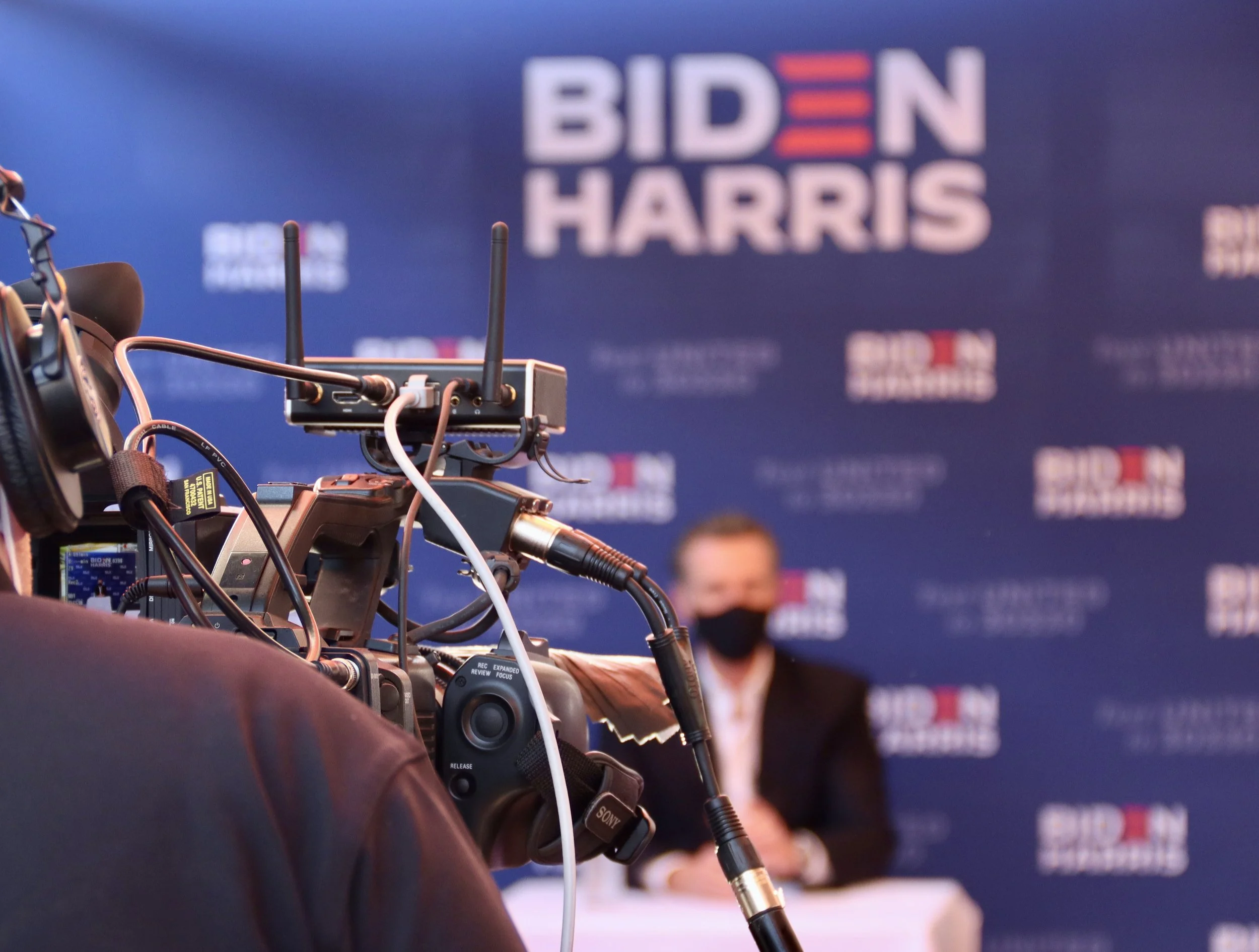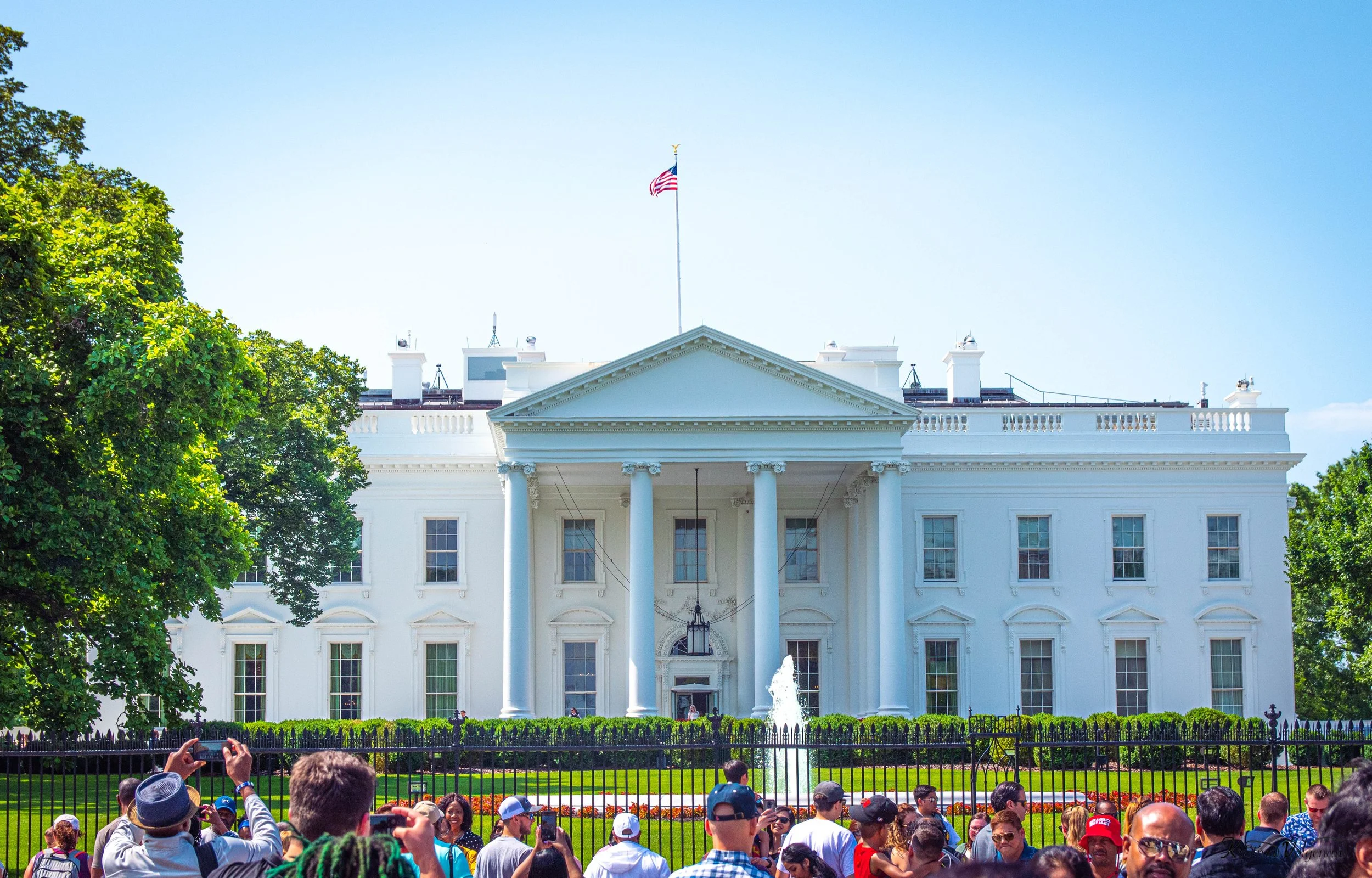On Monday, the headlines were ablaze with President Biden’s executive order addressing safe, secure, and trustworthy Artificial Intelligence. At 111 pages, the order offers a breadth of policy frameworks and standards creation that affect government operations and industry reporting. “The Executive Order establishes new standards for AI safety and security, protects Americans’ privacy, advances equity and civil rights, stands up for consumers and workers, promotes innovation and competition …and more.” (White House Fact Sheet)
For artists and arts organizations, several areas of note have a direct potential impact on their work: Watermarks of content authenticity, Copyright, and Labor.
Image: Press Conference Under President Biden
Image Source: Unsplash
Proof of Authentic Content
The Department of Commerce is instructed to develop guidance for content authentication and watermarking to label AI-generated content. This will, in theory, protect citizens from fraud or other deceptions from AI-generated works. While this area supports the authenticity of digital creation, it directly affects the arts ecosystem. Artists and organizations that use AI in content generation for social media or art - making can get ahead of the market by beginning to create on-brand indications of AI-generated materials.
Workers+ Innovation
AI will require a transformation of every industry’s workforce and will displace some current positions. The order supports this transition through a model of principles and practices for industries to follow, including the federal government itself, as the order reveals a plan to overhaul the federal government operations with a smart application of AI. Notably, the order addresses recommended changes in immigration to establish a strong US AI workforce to enable continued leadership and innovation in the space. The last 20 years of digital transformation has impacted all arts organizations and artists. Beginning to address digital strategies with organizations and artistic work will keep organizations on top of their fields.
Copyright, Patent, Trademark
The order tasks the US Patent and Trademark Office to publish guidelines to applicants and examiners on how to address the use of AI. The timeline is fast — within 120 days of the order. After that, the office is directed to determine how AI affects patent eligibility.
Significantly, while the US Copyright Office has said that AI cannot currently receive copyright that humans can receive, the order tasks the Office with creation recommended additional actions to provide a mode of copyright protection for AI-generated work and clarity of use of copyrighted work to train AI algorithms.
These forthcoming guidelines will obviously affect the intellectual property of artists. It is my hope that opt-in opportunities that align with merit-based compensation will be provided for AI training and that transparency in the marketplace is a core principle of patent, trademarks, and copyright laws moving forward.
Image: United States Patent and Trademark Office
Image Source: Saturday Evening Post
Other Notable Pieces to the Order
While these core areas are critical to the arts, other core functional areas across the government were also affected.
Reporting
According to one interview on NPR, social advocates for public policy constraining AI and big tech were pleased with the order. One reason is that it requires companies developing powerful AI tools to share their testing results with the federal government, which provides some governmental oversight of potential harms. The goal is that companies will ensure that before releasing an AI to the public they have been tested and that they are safe, secure, and trustworthy.
Standards
The standards for safety, security, and trustworthiness will be set by the National Institute for Standards and Technology. A similar expectation for a stringent set of standards is demanded from the Department of Energy and Homeland Security. In addition, all agencies handling life-science projects are expected to develop standards. As AI has been heralded as useful in the life sciences, it also has potentially disastrous effects.
The order instructs the military and intelligence agencies to also use AI effectively, ethically, and safely, according to their particular missions.
PROTECTION
The order enhances the ongoing AI Cyber Security challenge by harnessing AI to make software and networks more secure. It also recognizes the perils AI currently imparts with an eye to protecting citizens in the future.
“Without safeguards, AI can put Americans’ privacy further at risk. AI not only makes it easier to extract, identify, and exploit personal data, but it also heightens incentives to do so because companies use data to train AI systems. ”
Image: White House
Image Source: Unsplash
The order charges Congress to pass bi-partisan data privacy protection laws akin to the EU’s GDPR or California’s CCPA. Significantly, while the order recommends creating policies to protect citizens in the broader digital space, it also addresses the use of personal data in the federal government itself, questioning what is being purchased on the data marketplace and how the government is using and protecting the data that it has.
Equitable AI
AI is notoriously biased, as it was trained on data culled from a world affected by systemic racism. To wit, the Biden/Harris administration had already issued the Blueprint for an AI Bill of Rights and an executive order addressing racial equity support. Continuing in that vein, the order on AI attempts to ensure that as AI develops, it will actually advance equity and civil rights with a focus on AI algorithms used by landlords, federal benefits programs, and federal contractors. It also addresses the use of AI in the criminal justice system by asking that best practices in using AI in the system be developed and shared broadly.
Healthcare and Education are heavily impacted by the potential positive and negative effects of AI. The order requires that the Department of Health and Human Services establish a reporting system to identify harms and unsafe practices of AI in the healthcare system.
For educators, the order instructs the Department of Education to create resources to support educators developing AI-enabled education tools.
conclusion
The executive order focuses on creating standards and policies at the federal government level and government operations. Overall the Biden-Harris administration will work internationally to create a framework for the trustworthy use of AI worldwide. However, these standards and policies will directly affect the development of AI and how artists and organizations create and protect their works. Stay tuned and we will keep reporting on how this order roles out.
-
Mauran, Cecily and Kimberly Gedeon. “White House Drops an AI Regulation Bombshell: 10 New Mandates That’ll Shake up the Industry.” Mashable, October 30, 2023, https://mashable.com/article/white-house-drops-ai-regulation-bombshell.
Shivaram, Deepa. “Biden Plans to Step up Government Oversight of AI with New ‘Pressure Tests.” NPR, October 30, 2023, sec. Politics, https://www.npr.org/2023/10/30/1209343819/ai-biden-oversight-executive-order.
“Sweeping New Biden Order Aims to Alter the AI Landscape,” POLITICO, October 27, 2023, https://www.politico.com/news/2023/10/27/white-house-ai-executive-order-00124067.
The White House. “FACT SHEET: President Biden Issues Executive Order on Safe, Secure, and Trustworthy Artificial Intelligence.” The White House, October 30, 2023, https://www.whitehouse.gov/briefing-room/statements-releases/2023/10/30/fact-sheet-president-biden-issues-executive-order-on-safe-secure-and-trustworthy-artificial-intelligence/.




